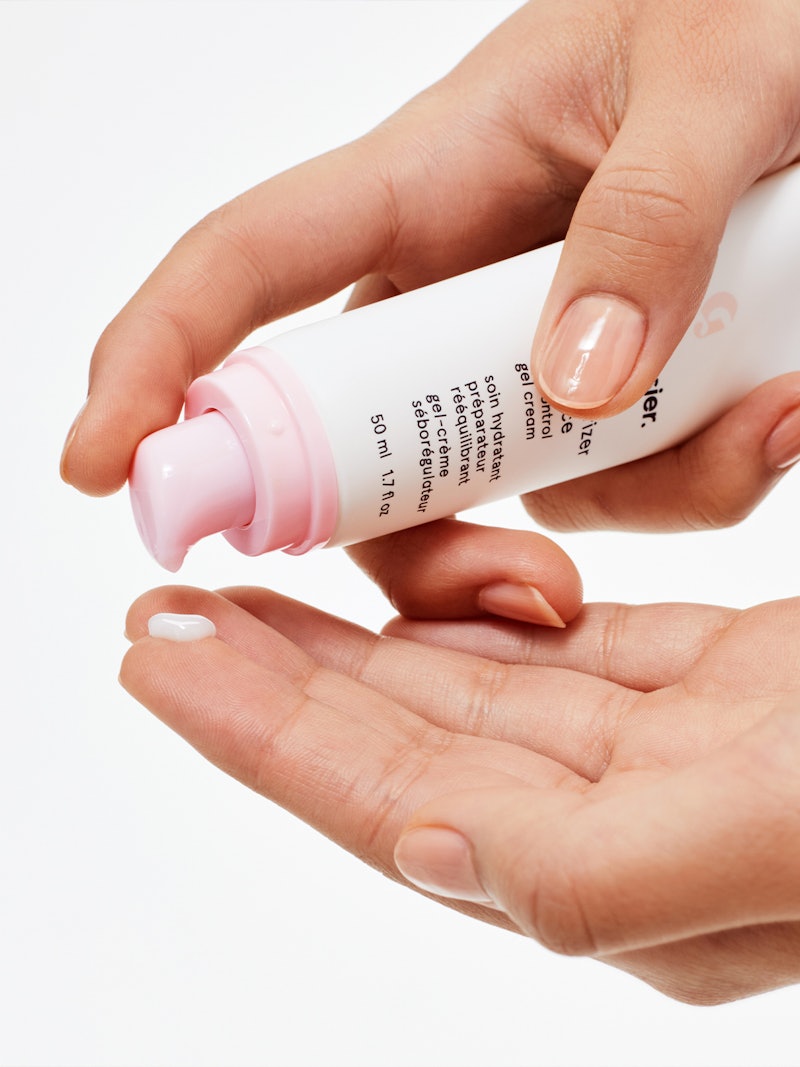
Glossier, the millennial-favorite skin care and makeup company, has made its mark on everything from cream blushes (hi, Cloud Paint) to cleansers. Now, its new Priming Moisturizer Balance brings more hybrid products to the brand.
Priming Moisturizer Balance is a matte take on the brand's existing Priming Moisturizer, which is designed for normal to dry skin types. The new version is made for those with oily skin (because hey, even the oiliest complexions still need moisture).
Ahead of its June 30 launch, I tested Glossier's new product to see how it works.
How Does Glossier's Priming Moisture Balance Help The Skin?
The moisturizer is made from apple fruit extract that the brand says helps lock in moisture (the pectin found in apples has been shown to improve skin barrier function which, in turn, prevents transepidermal water loss). The product also contains a marine-based extract designed to keep shine at bay. While no studies point to the extract's ability to reduce shine, the ingredient can work as a humectant to draw moisture into the skin, and a study has found that, in combination with other ingredients, it may have anti-aging effects.
While the product does feature these unique ingredients, it also contains well-known and researched ones like niacinamide, which can help improve the look of pores, as well as willow bark and bamboo extract, both of which can smooth your skin.
How Do You Use Glossier's Priming Moisture Balance?
Priming Moisturizer Balance is a gel-cream formula, meaning it absorbs easily into the skin and isn't thick or heavy. Thanks to its lightweight texture, you can use it both day and night. Simply apply it after you've cleansed your face and have applied any serums you use. A single pump is plenty for your entire face.
How Does Glossier's Priming Moisture Balance Work?
The formula is ideal for those who have trouble finding a moisturizer that doesn't make them feel oily, and it provides the perfect amount of moisture. I'd immediately recommend this to anyone with oily skin.
My skin, however, is combination-dry, meaning Glossier's new launch isn't quite enough of a moisturizer for me, even in the daytime when I typically use a more lightweight product. But that's fine — Glossier clearly explains that the new product was designed specifically for those with oily skin.
While Priming Moisturizer Balance is predominantly a skin care product, it's also somewhat of a hybrid makeup item. Think of it as the matte cousin to the brand's other hybrid, Future Dew. So instead of using it as a moisturizer, I used it as a primer.
Because I have combination skin, I experience some oiliness in my T-zone, especially when I'm wearing a full face of makeup. To remedy this, I applied the new Glossier product to my nose, cheeks, and forehead after my usual moisturizer. The area instantly looked more matte, and once my makeup was on, my T-zone stayed shine-free for the six or so hours I wore foundation.
Since the initial trial, I've continued using the product this way instead of as a moisturizer, and it's just as good as any mattifying primer I've ever used.
Should You Try Glossier's Priming Moisturizer Balance?
For those with oily skin, Glossier's Priming Moisturizer Balance could be your new holy grail. It's the most mattifying moisturizer I've ever tried and leaves behind no sort of residue or greasiness. When I wore it as a primer, no oil seeped through all day.
If, however, you've got dry or even normal skin, this may not be the product for you. But don't discount Glossier — the brand also has its original Priming Moisturizer that's much more hydrating and also worth a shot.
Sources:
Garre, A., Martinez-Masana, G., Piquero-Casals, J., Granger, C. (2017). Redefining face contour with a novel anti-aging cosmetic product: an open-label, prospective clinical study. Clinical, Cosmetic, and Investigational Dermatology. https://www.ncbi.nlm.nih.gov/pmc/articles/PMC5691901/
Levin, J., Momin, S. (2010). How Much Do We Really Know About Our Favorite Cosmeceutical Ingredients? The Journal of Clinical and Aesthetic Dermatology. https://www.ncbi.nlm.nih.gov/pmc/articles/PMC2921764/
Gopaul, R., Knaggs, H., Lephart, J., Holley, K., Gibson, E. (2010). An Evaluation of the Effect of a Topical Product Containing Salicin on the Visible Signs of Human Skin Aging. Journal of Cosmetic Dermatology. https://pubmed.ncbi.nlm.nih.gov/20883292/
Vasave, H., Wasule, D., Bobade, R. (2019). Bamboo's Extract for Rejuvenating Skin. International Journal of Scientific Development and Research. http://www.ijsdr.org/papers/IJSDR1907024.pdf